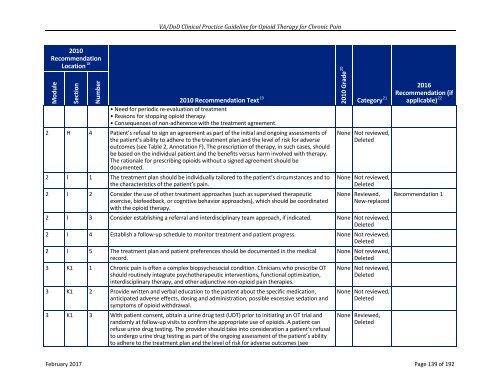VA/DoD CLINICAL PRACTICE GUIDELINE FOR OPIOID THERAPY FOR CHRONIC PAIN
2lfFhbO
2lfFhbO
Create successful ePaper yourself
Turn your PDF publications into a flip-book with our unique Google optimized e-Paper software.
<strong>VA</strong>/<strong>DoD</strong> Clinical Practice Guideline for Opioid Therapy for Chronic Pain<br />
2010<br />
Recommendation<br />
Location 18 2010 Recommendation Text 19<br />
Module<br />
Section<br />
Number<br />
• Need for periodic re-evaluation of treatment<br />
• Reasons for stopping opioid therapy<br />
• Consequences of non-adherence with the treatment agreement.<br />
2 H 4 Patient’s refusal to sign an agreement as part of the initial and ongoing assessments of<br />
the patient’s ability to adhere to the treatment plan and the level of risk for adverse<br />
outcomes (see Table 2, Annotation F). The prescription of therapy, in such cases, should<br />
be based on the individual patient and the benefits versus harm involved with therapy.<br />
The rationale for prescribing opioids without a signed agreement should be<br />
documented.<br />
2 I 1 The treatment plan should be individually tailored to the patient’s circumstances and to<br />
the characteristics of the patient’s pain.<br />
2 I 2 Consider the use of other treatment approaches (such as supervised therapeutic<br />
exercise, biofeedback, or cognitive behavior approaches), which should be coordinated<br />
with the opioid therapy.<br />
2010 Grade 20<br />
2016<br />
Recommendation (if<br />
Category 21 applicable) 22<br />
None Not reviewed,<br />
Deleted<br />
None Not reviewed,<br />
Deleted<br />
None Reviewed,<br />
New-replaced<br />
2 I 3 Consider establishing a referral and interdisciplinary team approach, if indicated. None Not reviewed,<br />
Deleted<br />
2 I 4 Establish a follow-up schedule to monitor treatment and patient progress. None Not reviewed,<br />
Deleted<br />
2 I 5 The treatment plan and patient preferences should be documented in the medical<br />
record.<br />
3 K1 1 Chronic pain is often a complex biopsychosocial condition. Clinicians who prescribe OT<br />
should routinely integrate psychotherapeutic interventions, functional optimization,<br />
interdisciplinary therapy, and other adjunctive non-opioid pain therapies.<br />
3 K1 2 Provide written and verbal education to the patient about the specific medication,<br />
anticipated adverse effects, dosing and administration, possible excessive sedation and<br />
symptoms of opioid withdrawal.<br />
3 K1 3 With patient consent, obtain a urine drug test (UDT) prior to initiating an OT trial and<br />
randomly at follow-up visits to confirm the appropriate use of opioids. A patient can<br />
refuse urine drug testing. The provider should take into consideration a patient’s refusal<br />
to undergo urine drug testing as part of the ongoing assessment of the patient’s ability<br />
to adhere to the treatment plan and the level of risk for adverse outcomes (see<br />
None Not reviewed,<br />
Deleted<br />
None Not reviewed,<br />
Deleted<br />
None Not reviewed,<br />
Deleted<br />
None Reviewed,<br />
Deleted<br />
Recommendation 1<br />
February 2017 Page 139 of 192


